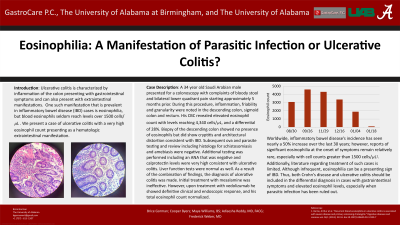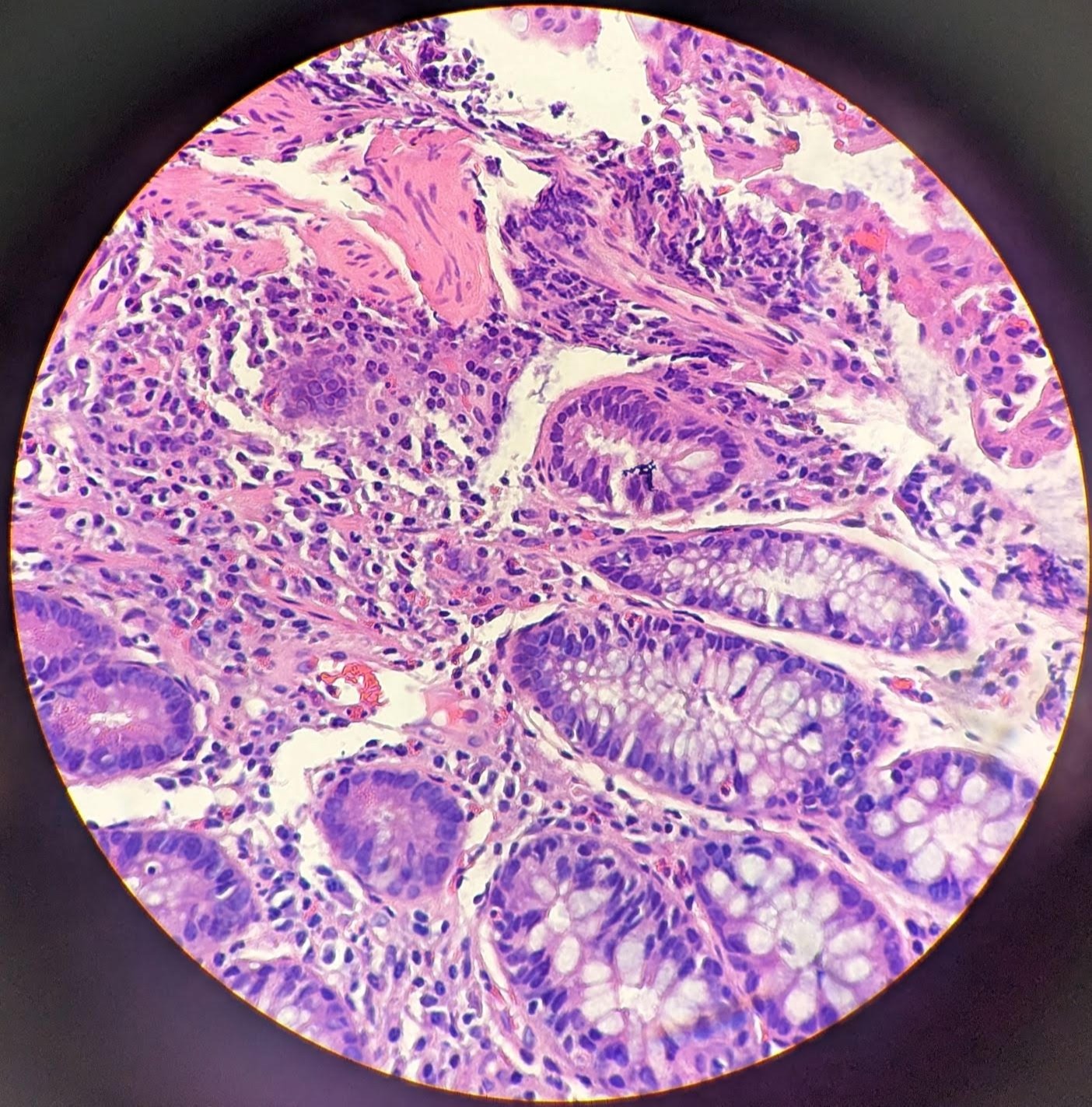Monday Poster Session
Category: IBD
P2235 - Eosinophilia: A Manifestation of Parasitic Infection or Ulcerative Colitis?
Monday, October 23, 2023
10:30 AM - 4:15 PM PT
Location: Exhibit Hall

Has Audio
- BG
Brice Gorman
University of Alabama
Tuscaloosa, AL
Presenting Author(s)
Brice Gorman, 1, Cooper Byers, 1, Maya Williams, 1, Adisesha Reddy, MD, FACG2, Frederick Weber, MD3
1University of Alabama, Tuscaloosa, AL; 2GastroCare P.C., Tuscaloosa, AL; 3University of Alabama at Birmingham, Birmingham, AL
Introduction: Ulcerative colitis is characterized by inflammation of the colon presenting with gastrointestinal symptoms and can also present with extraintestinal manifestations. One such manifestation that is prevalent in inflammatory bowel disease (IBD) cases is eosinophilia, but blood eosinophils seldom reach levels over 1500 cells/𝜇L1. We present a case of ulcerative colitis with a very high eosinophil count presenting as a hematologic extraintestinal manifestation.
Case Description/Methods: A 34 year old Saudi Arabian male presented for a colonoscopy with complaints of bloody stool and bilateral lower quadrant pain starting approximately 5 months prior. During this procedure, inflammation, friability and granularity were noted in the descending colon, sigmoid colon and rectum. His CBC revealed elevated eosinophil count with levels reaching 4,340 cells/𝜇L, and a differential of 28%. Biopsy of the descending colon showed no presence of eosinophils but did show cryptitis and architectural distortion consistent with IBD. Subsequent ova and parasite testing and review including histology for schistosomiasis and amebiasis were negative. Additional testing was performed including an ANA that was negative and calprotectin levels were very high consistent with ulcerative colitis. Liver function tests were normal as well. As a result of the combination of findings, the diagnosis of ulcerative colitis was made. Initial treatment with mesalamine was ineffective. However, upon treatment with vedolizumab he showed definitive clinical and endoscopic response, and his total eosinophil count normalized.
Discussion: Worldwide, inflammatory bowel disease’s incidence has seen nearly a 50% increase over the last 30 years; however, reports of significant eosinophilia at the onset of symptoms remain relatively rare, especially with cell counts greater than 1500 cells/𝜇L1. Additionally, literature regarding treatment of such cases is limited. Although infrequent, eosinophilia can be a presenting sign of IBD. Thus, both Crohn's disease and ulcerative colitis should be included in the differential diagnosis in cases with gastrointestinal symptoms and elevated eosinophil levels, especially when parasitic infection has been ruled out.
1Barrie, Arthur et al. “Recurrent blood eosinophilia in ulcerative colitis is associated with severe disease and primary sclerosing cholangitis.” Digestive diseases and sciences vol. 58,1 (2013): 222-8. doi:10.1007/s10620-012-2329-7

Disclosures:
Brice Gorman, 1, Cooper Byers, 1, Maya Williams, 1, Adisesha Reddy, MD, FACG2, Frederick Weber, MD3. P2235 - Eosinophilia: A Manifestation of Parasitic Infection or Ulcerative Colitis?, ACG 2023 Annual Scientific Meeting Abstracts. Vancouver, BC, Canada: American College of Gastroenterology.
1University of Alabama, Tuscaloosa, AL; 2GastroCare P.C., Tuscaloosa, AL; 3University of Alabama at Birmingham, Birmingham, AL
Introduction: Ulcerative colitis is characterized by inflammation of the colon presenting with gastrointestinal symptoms and can also present with extraintestinal manifestations. One such manifestation that is prevalent in inflammatory bowel disease (IBD) cases is eosinophilia, but blood eosinophils seldom reach levels over 1500 cells/𝜇L1. We present a case of ulcerative colitis with a very high eosinophil count presenting as a hematologic extraintestinal manifestation.
Case Description/Methods: A 34 year old Saudi Arabian male presented for a colonoscopy with complaints of bloody stool and bilateral lower quadrant pain starting approximately 5 months prior. During this procedure, inflammation, friability and granularity were noted in the descending colon, sigmoid colon and rectum. His CBC revealed elevated eosinophil count with levels reaching 4,340 cells/𝜇L, and a differential of 28%. Biopsy of the descending colon showed no presence of eosinophils but did show cryptitis and architectural distortion consistent with IBD. Subsequent ova and parasite testing and review including histology for schistosomiasis and amebiasis were negative. Additional testing was performed including an ANA that was negative and calprotectin levels were very high consistent with ulcerative colitis. Liver function tests were normal as well. As a result of the combination of findings, the diagnosis of ulcerative colitis was made. Initial treatment with mesalamine was ineffective. However, upon treatment with vedolizumab he showed definitive clinical and endoscopic response, and his total eosinophil count normalized.
Discussion: Worldwide, inflammatory bowel disease’s incidence has seen nearly a 50% increase over the last 30 years; however, reports of significant eosinophilia at the onset of symptoms remain relatively rare, especially with cell counts greater than 1500 cells/𝜇L1. Additionally, literature regarding treatment of such cases is limited. Although infrequent, eosinophilia can be a presenting sign of IBD. Thus, both Crohn's disease and ulcerative colitis should be included in the differential diagnosis in cases with gastrointestinal symptoms and elevated eosinophil levels, especially when parasitic infection has been ruled out.
1Barrie, Arthur et al. “Recurrent blood eosinophilia in ulcerative colitis is associated with severe disease and primary sclerosing cholangitis.” Digestive diseases and sciences vol. 58,1 (2013): 222-8. doi:10.1007/s10620-012-2329-7

Figure: Benign ulcerated colonic mucosa with cryptitis and architectural distortion, taken from the descending colon.
Disclosures:
Brice Gorman indicated no relevant financial relationships.
Cooper Byers indicated no relevant financial relationships.
Maya Williams indicated no relevant financial relationships.
Adisesha Reddy indicated no relevant financial relationships.
Frederick Weber indicated no relevant financial relationships.
Brice Gorman, 1, Cooper Byers, 1, Maya Williams, 1, Adisesha Reddy, MD, FACG2, Frederick Weber, MD3. P2235 - Eosinophilia: A Manifestation of Parasitic Infection or Ulcerative Colitis?, ACG 2023 Annual Scientific Meeting Abstracts. Vancouver, BC, Canada: American College of Gastroenterology.
